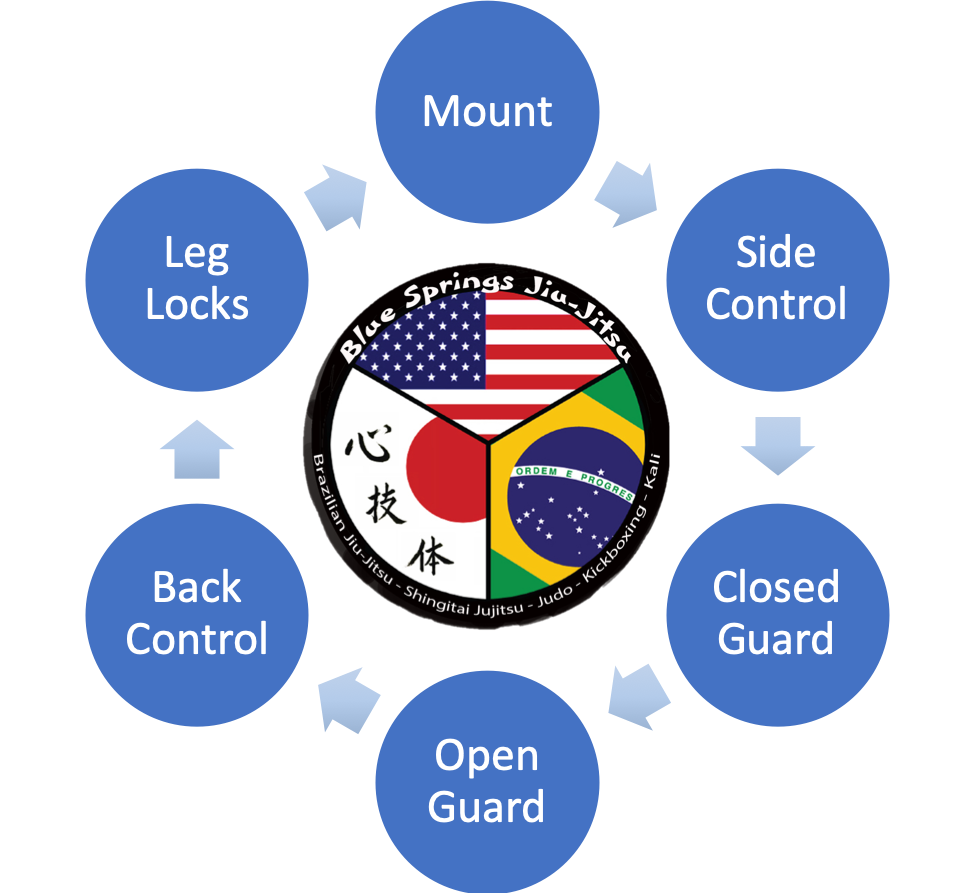BJJ Curriculum Overview
At Blue Springs Jiu-Jitsu, we use a structured curriculum that makes it easy for our students to follow. We’ve broken down all of the techniques we teach into six positional sections: Mount, Side Control, Closed Guard, Open Guard, Back Control, and Leg Locks. As this positional cycle progresses, we focus on various aspects of each position, including escaping tactics, control strategies, submission attacks, counters to submissions, and various others that are specific to each position. As the students attend both the Fundamentals and Advanced classes, they will follow this structure, which will assist the student in compartmentalizing the 500+ techniques that exist in Brazilian Jiu-Jitsu. Descriptions of the Fundamentals Class and the Advanced class are provided in the next section, describing the differences in how they are taught and what the student is expected to gain from each.

BJJ Fundamentals Class
The Fundamentals class provides the technical foundation for new students so that they can develop an understanding of both fundamentals techniques as well as how they tie together as a whole. The class is broken down into 26 lessons, which equates to 1 lesson per week and lasting 6 months. After 6 months, the lessons start back over and will be cycled again. Every lesson is preplanned to make it easy for the students to know what is expected at each class, and for easy review once the lesson is completed. The structure of the Fundamentals Class follows a sequential focus of five of the six positional sections described previously, excluding leg locks. The Leg Lock section is not included because attacks to the legs are generally not allowed in competition at the white belt level, which is for the reason of safety from injury. Beginning with the Mount position, there will be a lesson focussed on escapes, controls, submissions, and submission counters. Next is Side Control, which also focuses on the same positional sub-sections. Working though these, as well as Closed Guard, Open Guard and Back Control, the student will gain a breadth of knowledge in the quickest way. The Fundamentals Class lasts one hour, and is broken down into three, 20 minute segments which each focus on a different technique, as shown here.
Fundamentals
Technique List
Fundamentals Class Downloads
Here you will find the Fundamentals Class Technique List, as well as an example outline of one of the lessons, Lesson 1, which covers Mount Escapes. For more documents, our members can access the “BSJJ Members” page for additional files for downloading. These include lesson printouts for each of the 26 lessons of the Fundamentals Class curriculum, as well as other support documentation to facilitate learning and staying organized as you progress through the jiu-jitsu journey.
Lesson 1
Mount Escapes
BJJ Advanced Class
The Positional focus in the Advanced Class will progress linearly though each position, as outlined previously. The Mount and Side Control sections will each focus on four positional sub sections: escapes, controls, submissions, and submission counters. Also within the Side Control section, we will teach aspects of the knee on stomach position, as well as the north/south position, as they are specific positional components of Side Control. The Closed Guard section will first focus on sweeps, then passes, followed by submissions and finally submission counters. When the open guard section is reached, the first of the open guards will be half guard. Within half guard, there will be a focus on top half guard followed by a focus on bottom half guard. From there, the remaining open guards will each have their own respective multi-week focus, with sweeps, passes, and submission options being taught. The “hybrid guards” subsection refers to anything that combines strategies from multiple open guards. For example, butterfly half guard, single leg X-guard, reverse De la Riva, spider DLR guard, and various others that can exist. The Open Guard section will take several weeks to complete. The Back Control section is next and will focus on escapes, submissions and submission counters, as well as the turtle and crucifix positions that are common transitional aspects of back control. The sixth and final section of the cycle are Leg Locks. The positional sub-sections of Leg Locks include the four primary categories of leg entanglement positions: straight ankle locks, toe hold foot locks, knee locks and heel hooks. Each of these sub-sections will cover both offensive and defensive strategies for the various types of leg locks. As shown, each of these positional sections and subsections will progress in series, allowing for the students to know what is coming up at any given time.